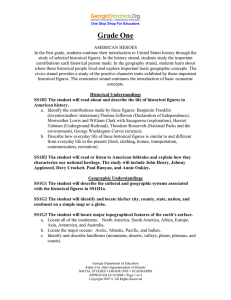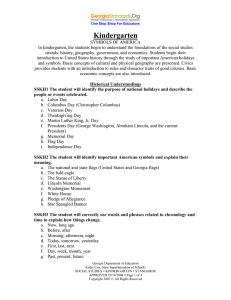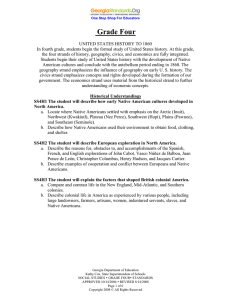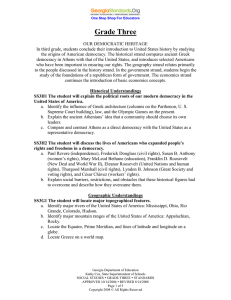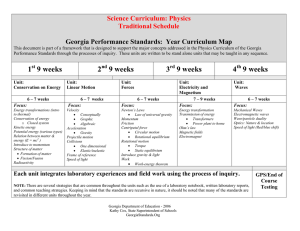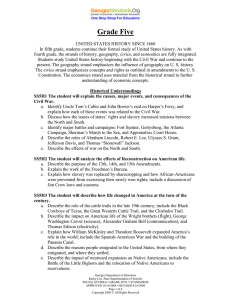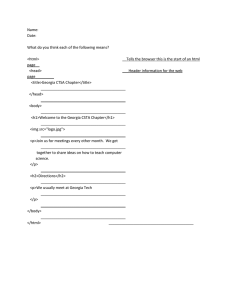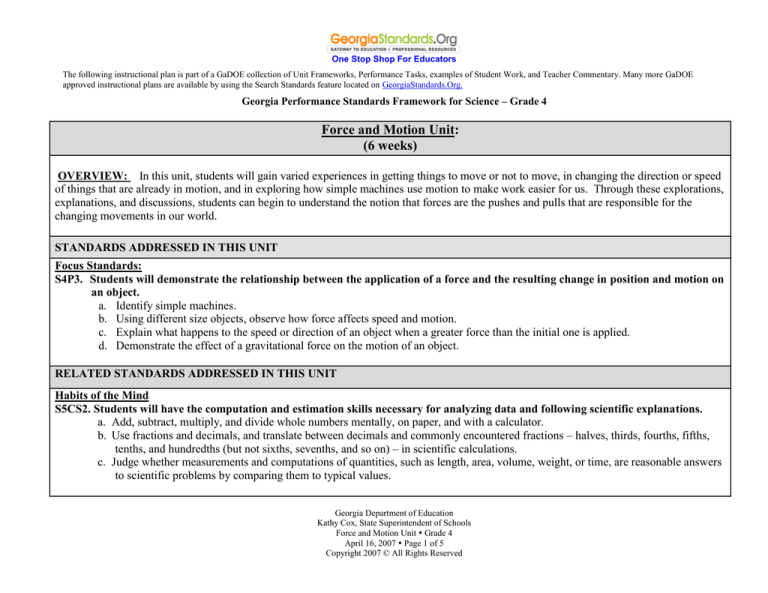
One Stop Shop For Educators
The following instructional plan is part of a GaDOE collection of Unit Frameworks, Performance Tasks, examples of Student Work, and Teacher Commentary. Many more GaDOE
approved instructional plans are available by using the Search Standards feature located on GeorgiaStandards.Org.
Georgia Performance Standards Framework for Science – Grade 4
Force and Motion Unit:
(6 weeks)
OVERVIEW: In this unit, students will gain varied experiences in getting things to move or not to move, in changing the direction or speed
of things that are already in motion, and in exploring how simple machines use motion to make work easier for us. Through these explorations,
explanations, and discussions, students can begin to understand the notion that forces are the pushes and pulls that are responsible for the
changing movements in our world.
STANDARDS ADDRESSED IN THIS UNIT
Focus Standards:
S4P3. Students will demonstrate the relationship between the application of a force and the resulting change in position and motion on
an object.
a. Identify simple machines.
b. Using different size objects, observe how force affects speed and motion.
c. Explain what happens to the speed or direction of an object when a greater force than the initial one is applied.
d. Demonstrate the effect of a gravitational force on the motion of an object.
RELATED STANDARDS ADDRESSED IN THIS UNIT
Habits of the Mind
S5CS2. Students will have the computation and estimation skills necessary for analyzing data and following scientific explanations.
a. Add, subtract, multiply, and divide whole numbers mentally, on paper, and with a calculator.
b. Use fractions and decimals, and translate between decimals and commonly encountered fractions – halves, thirds, fourths, fifths,
tenths, and hundredths (but not sixths, sevenths, and so on) – in scientific calculations.
c. Judge whether measurements and computations of quantities, such as length, area, volume, weight, or time, are reasonable answers
to scientific problems by comparing them to typical values.
Georgia Department of Education
Kathy Cox, State Superintendent of Schools
Force and Motion Unit Grade 4
April 16, 2007 Page 1 of 5
Copyright 2007 © All Rights Reserved
One Stop Shop For Educators
Georgia Performance Standards Framework for Science – Grade 4
S5CS3. Students will use tools and instruments for observing, measuring, and manipulating objects in scientific activities.
a. Choose appropriate common materials for making simple mechanical constructions and repairing things.
b. Measure and mix dry and liquid materials in prescribed amounts, exercising reasonable safety.
c. Use computers, cameras and recording devices for capturing information.
d. Identify and practice accepted safety procedures in manipulating science materials and equipment.
S5CS4. Students will use ideas of system, model, change, and scale in exploring scientific and technological matters.
a. Observe and describe how parts influence one another in things with many parts.
b. Use geometric figures, number sequences, graphs, diagrams, sketches, number lines, maps, and stories to represent corresponding
features of objects, events, and processes in the real world. Identify ways in which the representations do not match their original
counterparts.
c. Identify patterns of change in things—such as steady, repetitive, or irregular change—using records, tables, or graphs of
measurements where appropriate.
d. Identify the biggest and the smallest possible values of something.
S5CS5. Students will communicate scientific ideas and activities clearly.
a. Write instructions that others can follow in carrying out a scientific procedure.
b. Make sketches to aid in explaining scientific procedures or ideas.
c. Use numerical data in describing and comparing objects and events.
d. Locate scientific information in reference books, back issues of newspapers and magazines, CD-ROMs, and computer databases.
S5CS6. Students will question scientific claims and arguments effectively.
a. Support statements with facts found in books, articles, and databases, and identify the sources used.
b. Identify when comparisons might not be fair because some conditions are different.
The Nature of Science
S5CS7. Students will be familiar with the character of scientific knowledge and how it is achieved.
Students will recognize that:
a. Similar scientific investigations seldom produce exactly the same results, which may differ due to unexpected differences in
whatever is being investigated, unrecognized differences in the methods or circumstances of the investigation, or observational
Georgia Department of Education
Kathy Cox, State Superintendent of Schools
Force and Motion Unit Grade 4
April 16, 2007 Page 2 of 5
Copyright 2007 © All Rights Reserved
One Stop Shop For Educators
Georgia Performance Standards Framework for Science – Grade 4
uncertainties.
b. Some scientific knowledge is very old and yet is still applicable today.
S5CS8. Students will understand important features of the process of scientific inquiry.
Students will apply the following to inquiry learning practices:
a. Scientific investigations may take many different forms, including observing what things are like or what is happening somewhere,
collecting specimens for analysis, and doing experiments.
b. Clear and active communication is an essential part of doing science. It enables scientists to inform others about their work, expose
their ideas to criticism by other scientists, and stay informed about scientific discoveries around the world.
c. Scientists use technology to increase their power to observe things and to measure and compare things accurately.
d. Science involves many different kinds of work and engages men and women of all ages and backgrounds.
ENDURING UNDERSTANDINGS
The position and motion of an object can be described accurately
An object’s position can be described only by locating it relative to another question.
A force is simply a push or pull (usually on an object).
Forces can cause objects to start moving, stop moving, or change direction.
An object’s size and the amount of force exerted on an object affect its speed and motion.
Gravity is the earth’s pull on things. Things on or near the earth are pulled toward it by the earth's gravity.
Simple machines are tools that help us do work. Simple machines make work easier for us changing the amount of force (pushing or
pulling) needed to do certain kinds of work.
ESSENTIAL QUESTIONS:
How can forces be used to make objects move, change direction, or stop?
How is the motion of an object related to the size of the object and the amount of force that is applied to the object?
What is gravity and how does it affect things on the earth?
How do simple machines make work easier for people?
Georgia Department of Education
Kathy Cox, State Superintendent of Schools
Force and Motion Unit Grade 4
April 16, 2007 Page 3 of 5
Copyright 2007 © All Rights Reserved
One Stop Shop For Educators
Georgia Performance Standards Framework for Science – Grade 4
MISCONCEPTIONS
The only ―natural motion‖ is for an object to be at rest and, if an object
is at rest, there are no forces acting on the object.
It is natural for things to fall down toward the earth and there is no
need to consider gravity as a concept to help explain why objects in the
air fall to the earth.
Simple machines do work for us.
PROPER CONCEPTIONS
Even young children will gain an experiential understanding of
how forces are needed to change the motion of objects. They
learn that the harder that they throw a ball, the farther it will
travel, and that big moving objects are harder to stop than small
moving objects.
Forces are pushes or pulls on objects that are needed to make an
object change its motion. An object at rest will remain at rest
unless a force acts on it and an object in motion will remain in
motion unless a force acts on it.
Gravity is the earth’s pull on things. Things on or near the earth
are pulled toward it by the earth's gravity. Gravity is always
present.
Simple machines are tools that help us do work but they don’t do
it for us. Simple machines make work easier for us changing the
amount of force (pushing or pulling) needed to do certain kinds of
work.
CONCEPTS:
Forces, motion of objects, gravity, simple machines.
LANGUAGE:
force, pull, motion, gravity, speed, position, direction, pull, mass, simple machines, lever, pulley, inclined plane, wheel and axle, wedge, screw
EVIDENCE OF LEARNING:
By the conclusion of this unit, students should be able to demonstrate the following competencies:
Culminating Activity: Designing a Catapult: May the Force be with You.
Georgia Department of Education
Kathy Cox, State Superintendent of Schools
Force and Motion Unit Grade 4
April 16, 2007 Page 4 of 5
Copyright 2007 © All Rights Reserved
One Stop Shop For Educators
Georgia Performance Standards Framework for Science – Grade 4
By the conclusion of this unit, students should be able to demonstrate the following competencies:
Culminating Activity:
The Catapult Challenge
Goal: Students will apply knowledge and demonstrate their understanding of forces and motion by constructing a functional catapult that
launches objects.
Role: Warriors in the middle ages.
Audience: Peers, administrators, parents, public.
Scenario: Student warriors will work in groups to create a functional catapult out of everyday objects. These catapults are needed to launch
highly toxic but scrumptious snack food (marshmallows) into enemy territory. It is hoped that, after coaxing the enemy to ingest a multitude of
these tasty but super sugary treats, they will be sleepy, slow, and unprepared for the battle to follow.
Product:
Using what you’ve learned about forces and motion, your job is to create a functional catapult that will give you the upper hand in the
upcoming battle. As part of this process each group must complete the following:
1)
2)
3)
4)
5)
a detailed sketch of your catapult design
an explanation of your design making clear why you designed your catapult in the manner that you chose as a group
a data table showing the results of your test launches (minimum of 5)
a graph displaying these results
an explanation of how you tried to improve your design in order to improve your results
Georgia Department of Education
Kathy Cox, State Superintendent of Schools
Force and Motion Unit Grade 4
April 16, 2007 Page 5 of 5
Copyright 2007 © All Rights Reserved

